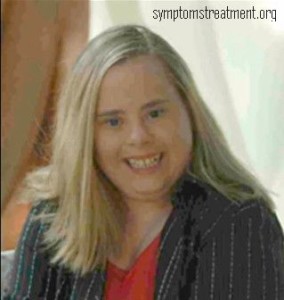Down syndrome is a hereditary disorder that may lead to life long deceleration of mental abilities, developmental delay and other physical issues. This condition varies in terms of severity, which is why development issues may range from moderate to severe. The syndrome is considered as one of the most common factors resulting in learning disabilities in children. It is believed that diagnosing and understanding the prevalence of the syndrome may make a big different in the physical abilities of the affected child as well as adults.
Symptoms of Down syndrome
Children afflicted with Down syndrome have anomalous facial features or appearance. However, not all of them may have noticeable facial irregularity. Here are some signs of the condition related to facial appearance.
• Flattened features of the face
• Protruding tongue
• Comparatively shorter neck
• Smaller head as compared to face
• Slightly upwards leaning eyes
• Unusually shaped or deformed ears
Other symptoms of Down Syndrome
• Poor residual muscles tension or poor muscles tone
• Broader and usually shorter palm with lesser or single crease
• Comparatively shorter fingers
• Flexibility to excessive extent
Infants with Down syndrome may be born in average size; however, their growth rate remains slow which makes them shorter as compared to other children of same age. For a child with this condition it takes double the time for walking and crawling as compared to a normal child. Most affected children also face mental retardation to certain extent, usually mild to moderate level.
Causes of Down syndrome:
Defects in chromosome is believed to be the chief cause of Down syndrome. It is studied that normally human cells contains chromosomes in pairs and there are 23 such pairs. Each pair of chromosome comes from is contributed by both mother and father, one comes from paternal side and the other from maternal side. When any one of the 3 cell division irregularity occurs related to chromosome 21, it may result in Down syndrome. In case all 3 cell division abnormality of chromosome 21 occurs it may cause issues related to development as well as characteristic features of this condition.
Trisomy 21:
Trisomy 21 is considered as a common factors causing Down syndrome as over 90 percent of cases are attributed to this particular cause. In this case an affected child carries 3 copies of chromosome 21 in all his cells rather than two copies as in normal cases. This factor causes anomalous cell divisions at the time of development of spermatozoan cell or cells of egg.
Mosaic Down syndrome:
This is a rare kind of Down syndrome. In this type of condition affected children have some cell containing additional copy of chromosome 21. This assortment of normal or anomalous cell is resulted by abnormal division of cell post fertilization.
Translocation Down syndrome:
The condition may also result if portion of chromosome 21 becomes translocated or attached to another chromosome during or prior to conception. Children affected with such kind of condition carries conventional two copies of chromosome 21 but they may also contain extra material this chromosome which is attached to the translocated chromosome. This is an uncommon kind of Down syndrome.
Most people may link the condition with some other causes. It should be known that there are no environmental or behavioral factors that may lead to such condition. The above mentioned are few causes understood by the medical industry. In most cases the condition may not be genetic, in fact it can be said that the syndrome is caused by mistake related to cell division during developmental stage of spermatozoa, egg or embryo. However, translocation type syndrome is the only kind of Down disorder which cab be inherited. Nevertheless even this condition is rare as only 4 percent of all Down syndrome cases are attributed to translocation of chromosomes. Out of this four percent only half of the affected children inherit the condition from one of their parents. If the father is carrier then there are 3 percent chances of the child being affected with the condition. Whereas, if the mother is carrier then there are approx 10 to 15 percent chances that the child will suffer from translocation Down syndrome.
Treatment and drugs for Down syndrome:
Early revelation of prevalence of the condition in children may help in enabling the child to cope with the syndrome and lead a little better life. It may help in realizing the ability of the child and help him improve his skills.
Early Intervention programs:
Early intervention programs are specialized programs that may help your child to overcome issues related to the syndrome. It helps the affected child to develop appropriate sensory ability, motor skills and cognitive abilities. These programs are available in most sates. There may be difference in the program structure; however, the core objective remains the same. In this program, educator and therapists help you child enhance his/ her motor abilities, communication skills, self- help abilities and social abilities.
Team efforts:
Team efforts make it easy for your child to understand and learn better. The results obtained through team care are better than individual care. There is a team of specialist who will provide medical care to your child as well as try to develop physical skills as far as possible. Apart from the primary health care expert or pediatrician, the team of experts may include:
• Cardiologist
• Pediatric Gastroenterology expert
• Endocrinologist
• Pediatric Neurologist
• Developmental expert
• Audiologist
• Speech and language pathologist
• Occupational therapist also abbreviated as OT
• Physiotherapist also referred to as physical therapist
For a child affected with this syndrome, it may take double the time to learn walking, crawling etc. However, when early intervention program is adopted immediately, it may help your child to learn and grab things faster as compared to other child with same physical issues but not medical aid. Hence, timely diagnosis as well as early intervention plan may help your child lead a close- to- normal life even under prevalence of Down syndrome.
Down Syndrome Pictures




edmychap 6368f9b739 https://wakelet.com/wake/rWGu1kugpzc-LReoAKpWt
janfio 5d27fc3d97 https://wakelet.com/wake/JR80yQl5VuNbyqOqzqKqG
janfio 5d27fc3d97 https://wakelet.com/wake/JR80yQl5VuNbyqOqzqKqG
janfio 5d27fc3d97 https://wakelet.com/wake/JR80yQl5VuNbyqOqzqKqG
janfio 5d27fc3d97 https://wakelet.com/wake/JR80yQl5VuNbyqOqzqKqG
latnic c2bcea2ebb https://wakelet.com/wake/tpNQtGyizGvWBVU1hHckj
obevane c2bcea2ebb https://wakelet.com/wake/ocRbJvqZL9u6-NQrsxXhZ
carlbird c2bcea2ebb https://wakelet.com/wake/LEGJiYVszk0Xj6S-QMyls
carlbird c2bcea2ebb https://wakelet.com/wake/LEGJiYVszk0Xj6S-QMyls
rehell f91c64177c https://fdocuments.in/document/ccleaner-pro-5456611-crack-with-serial-key-full-version.html
derwak f91c64177c https://pobanevertherea.wixsite.com/pittpretater/post/avs-edi-r-9-1-1-340-full-version-windows-crack-64bit
derwak f91c64177c https://pobanevertherea.wixsite.com/pittpretater/post/avs-edi-r-9-1-1-340-full-version-windows-crack-64bit
derwak f91c64177c https://pobanevertherea.wixsite.com/pittpretater/post/avs-edi-r-9-1-1-340-full-version-windows-crack-64bit
beteld f91c64177c https://yadirakuanoni436za.wixsite.com/prodelrespi/post/64-transmac-12-2-rar-file-full-crack
agreche f91c64177c https://cdn.thingiverse.com/assets/4e/82/e5/14/5f/wanted_online_subtitrat_hd_72020golkes.html
bethald f91c64177c https://kit.co/brazhyrencatt/film-the-raanjhanaa-avi-utorrent-avi-kickass
bethald f91c64177c https://kit.co/brazhyrencatt/film-the-raanjhanaa-avi-utorrent-avi-kickass
bethald f91c64177c https://kit.co/brazhyrencatt/film-the-raanjhanaa-avi-utorrent-avi-kickass
broohave f91c64177c https://trello.com/c/DssCfEsR/22-the-klub-17-v75-822
broohave f91c64177c https://trello.com/c/DssCfEsR/22-the-klub-17-v75-822
broohave f91c64177c https://trello.com/c/DssCfEsR/22-the-klub-17-v75-822
broohave f91c64177c https://trello.com/c/DssCfEsR/22-the-klub-17-v75-822
broohave f91c64177c https://trello.com/c/DssCfEsR/22-the-klub-17-v75-822
wesneel f91c64177c https://www.drupal.org/files/issues/2021-11-26/brianwel.pdf
wesneel f91c64177c https://www.drupal.org/files/issues/2021-11-26/brianwel.pdf
walrei f91c64177c https://wakelet.com/wake/-7UYAaMs8qV9nBYaC1lBd
walrei f91c64177c https://wakelet.com/wake/-7UYAaMs8qV9nBYaC1lBd
ninlysa f91c64177c https://riparsmarea.mystrikingly.com/blog/jungheinrich-efg-220-error-codes
ninlysa f91c64177c https://riparsmarea.mystrikingly.com/blog/jungheinrich-efg-220-error-codes
ninlysa f91c64177c https://riparsmarea.mystrikingly.com/blog/jungheinrich-efg-220-error-codes
ninlysa f91c64177c https://riparsmarea.mystrikingly.com/blog/jungheinrich-efg-220-error-codes
ninlysa f91c64177c https://riparsmarea.mystrikingly.com/blog/jungheinrich-efg-220-error-codes
carylyv f91c64177c https://wakelet.com/wake/Jz5xnKLmV0Wh4_k9M35Wm
carylyv f91c64177c https://wakelet.com/wake/Jz5xnKLmV0Wh4_k9M35Wm
carylyv f91c64177c https://wakelet.com/wake/Jz5xnKLmV0Wh4_k9M35Wm
sakfabi f91c64177c https://mooferreloho.wixsite.com/proskingfansu/post/solucionario-de-estadistica-metodos-y-aplicaciones-de-edwin-galindo-13
wensbeth f91c64177c https://cdn.thingiverse.com/assets/ea/5a/f1/3d/86/AutoCAD-Mechanical-2005-32-Bit-Crack-Torrent-Download.html
qeneell f91c64177c https://trello.com/c/xE8cdeft/32-1st-studio-siberian-mouse-mm-27-151
qeneell f91c64177c https://trello.com/c/xE8cdeft/32-1st-studio-siberian-mouse-mm-27-151
qeneell f91c64177c https://trello.com/c/xE8cdeft/32-1st-studio-siberian-mouse-mm-27-151
qeneell f91c64177c https://trello.com/c/xE8cdeft/32-1st-studio-siberian-mouse-mm-27-151
genglas f91c64177c https://seesaawiki.jp/alstylrehar/d/Come Scaricare Full __FULL__ Software 32bit Pc Download
genglas f91c64177c https://seesaawiki.jp/alstylrehar/d/Come Scaricare Full __FULL__ Software 32bit Pc Download
genglas f91c64177c https://seesaawiki.jp/alstylrehar/d/Come Scaricare Full __FULL__ Software 32bit Pc Download
genglas f91c64177c https://seesaawiki.jp/alstylrehar/d/Come Scaricare Full __FULL__ Software 32bit Pc Download
engling f91c64177c https://antiewhicon.amebaownd.com/posts/22067776
faywani f91c64177c https://cionogsime.mystrikingly.com/blog/x32-lgshark-rar-key-torrent-serial-windows-full-version
ohiyign f91c64177c https://wakelet.com/wake/Oj6PeebtDz0sFhvONoyzw
jaciall f91c64177c https://cdn.thingiverse.com/assets/9c/36/27/2c/6f/2d_Fighter_Maker_2nd_Player_Data_Download.html
delajan f91c64177c https://seesaawiki.jp/lighbeterro/d/!FREE! Software Sims 3 V1 67 2 0240xx Exe Download Patch 64 Pc
tamadel f91c64177c https://wakelet.com/wake/voLBthVMfVd_SgMG3ipZi
tamadel f91c64177c https://wakelet.com/wake/voLBthVMfVd_SgMG3ipZi
taluis f91c64177c https://wakelet.com/wake/U0crhgg0va_IBoaJbsHBq
taluis f91c64177c https://wakelet.com/wake/U0crhgg0va_IBoaJbsHBq
taluis f91c64177c https://wakelet.com/wake/U0crhgg0va_IBoaJbsHBq
cassail f91c64177c https://kit.co/grapperrelin/texas-rising-complete-series-watch-online-english-1080-hd-english
cassail f91c64177c https://kit.co/grapperrelin/texas-rising-complete-series-watch-online-english-1080-hd-english
cassail f91c64177c https://kit.co/grapperrelin/texas-rising-complete-series-watch-online-english-1080-hd-english
rexasam f91c64177c http://losuclowe.unblog.fr/2021/11/26/new-br-3021-shock-manual/
harltak f91c64177c https://loulindbiberbino.wixsite.com/dalsingbarcblok/post/switch-bot-v3-pumt2-free-windows-latest-32bit
brilyasm f91c64177c https://borbacknewsromp.mystrikingly.com/blog/free-sexy-3gp-download
brilyasm f91c64177c https://borbacknewsromp.mystrikingly.com/blog/free-sexy-3gp-download
brilyasm f91c64177c https://borbacknewsromp.mystrikingly.com/blog/free-sexy-3gp-download
wahking f91c64177c https://wakelet.com/wake/gE6sQRtC5I5b5J2BaQcvj
wahking f91c64177c https://wakelet.com/wake/gE6sQRtC5I5b5J2BaQcvj
wahking f91c64177c https://wakelet.com/wake/gE6sQRtC5I5b5J2BaQcvj
ohaisad f91c64177c https://pdfslide.us/documents/pantalones-cortos-lara-rios-pdf-28l.html
marpasc f91c64177c https://marinapeterson1998.wixsite.com/prottensampce/post/alpine-imprint-software-v2-10-cd-rom-download
marpasc f91c64177c https://marinapeterson1998.wixsite.com/prottensampce/post/alpine-imprint-software-v2-10-cd-rom-download
marpasc f91c64177c https://marinapeterson1998.wixsite.com/prottensampce/post/alpine-imprint-software-v2-10-cd-rom-download
geoyasm f91c64177c https://inpoucusbanal.wixsite.com/presarculba/post/x-force-registration-keygen-64bit-full-windows
geoyasm f91c64177c https://inpoucusbanal.wixsite.com/presarculba/post/x-force-registration-keygen-64bit-full-windows
geoyasm f91c64177c https://inpoucusbanal.wixsite.com/presarculba/post/x-force-registration-keygen-64bit-full-windows
geoyasm f91c64177c https://inpoucusbanal.wixsite.com/presarculba/post/x-force-registration-keygen-64bit-full-windows
vigkala f91c64177c https://vdocuments.mx/ueberschall-balkan-lines-keygen-music.html
kaylvil f91c64177c https://staracorsiekaxa.wixsite.com/serelsynchling/post/company-of-heroes-tales-of-valor-product-x64-cracked-exe-software
waihend f91c64177c https://wakelet.com/wake/WmLq4b5kIz3tO-9tBcd57
vykifly f91c64177c https://cdn.thingiverse.com/assets/3d/14/cd/dc/b8/amertom14.html
darvivy f91c64177c https://reslackfimolive.wixsite.com/conbirthrighma/post/bioshock-infinite-nude-mod-free-working-download-updated-2013-05-22
nitytal f91c64177c https://s3.amazonaws.com/media.muckrack.com/portfolio/items/14881836/Manorama-Six-Feet-Under-Hd-1080p-In-Hindi-Download.pdf
nitytal f91c64177c https://s3.amazonaws.com/media.muckrack.com/portfolio/items/14881836/Manorama-Six-Feet-Under-Hd-1080p-In-Hindi-Download.pdf
geladal f91c64177c https://pdfslide.tips/lifestyle/mobile-dvdrip-torrent-watch-online-1080p.html
geladal f91c64177c https://pdfslide.tips/lifestyle/mobile-dvdrip-torrent-watch-online-1080p.html
geladal f91c64177c https://pdfslide.tips/lifestyle/mobile-dvdrip-torrent-watch-online-1080p.html
furvyk dd23f8915e https://www.cloudschool.org/activities/ahFzfmNsb3Vkc2Nob29sLWFwcHI5CxIEVXNlchiAgIC_47iWCwwLEgZDb3Vyc2UYgICAn5u_nggMCxIIQWN0aXZpdHkYgIDA4KWS6goMogEQNTcyODg4NTg4Mjc0ODkyOA
wendalm 79a0ff67a5 https://coub.com/stories/2786196-new-3-djtf-webinars-to-prepare-you-for-the-2014-nabjvconvention
wendalm 79a0ff67a5 https://coub.com/stories/2786196-new-3-djtf-webinars-to-prepare-you-for-the-2014-nabjvconvention
irepear 79a0ff67a5 https://coub.com/stories/2822970-_top_-the-heavens-declare-the-glory-of-god-psalmv25-1
irepear 79a0ff67a5 https://coub.com/stories/2822970-_top_-the-heavens-declare-the-glory-of-god-psalmv25-1
irepear 79a0ff67a5 https://coub.com/stories/2822970-_top_-the-heavens-declare-the-glory-of-god-psalmv25-1